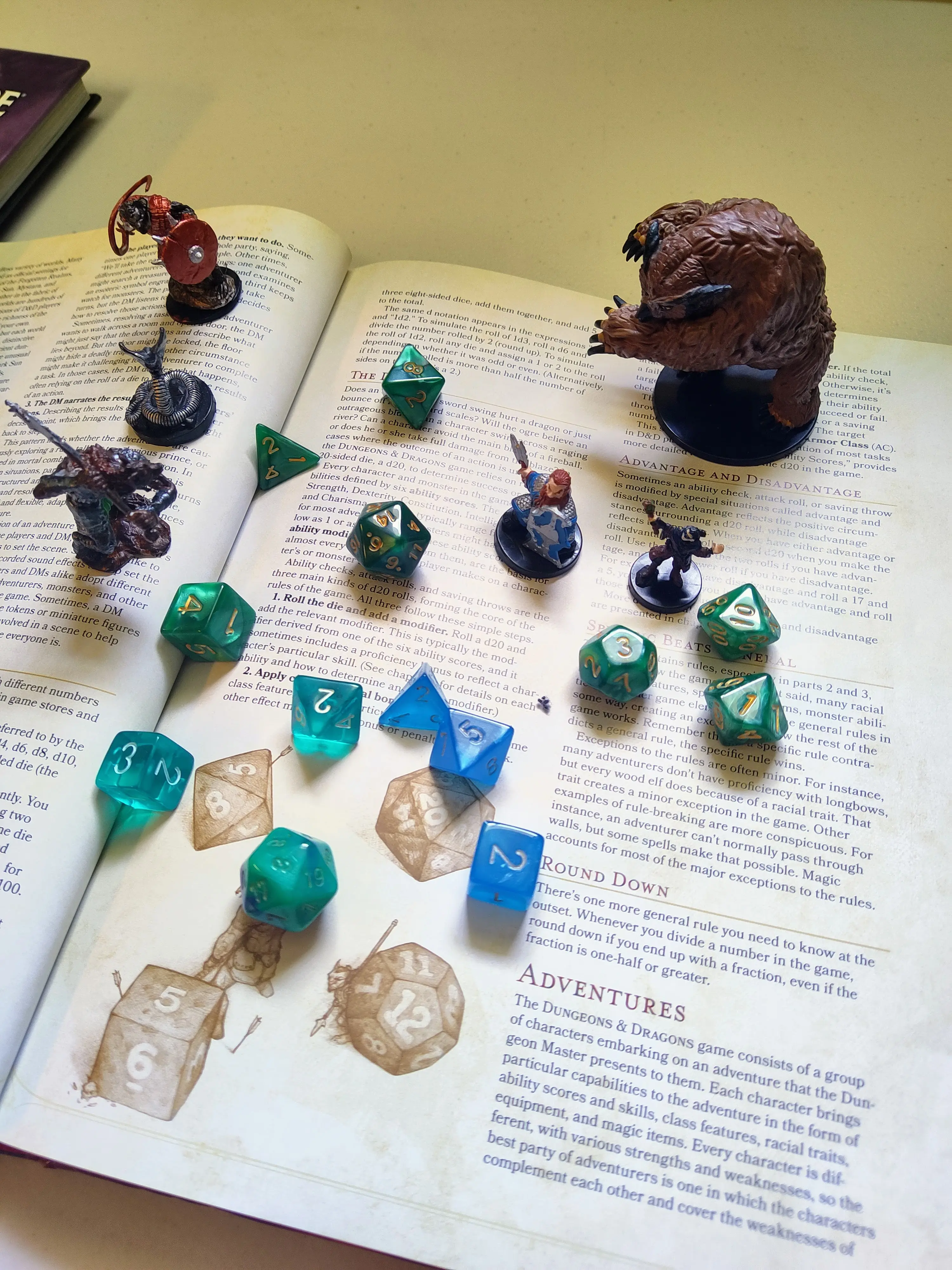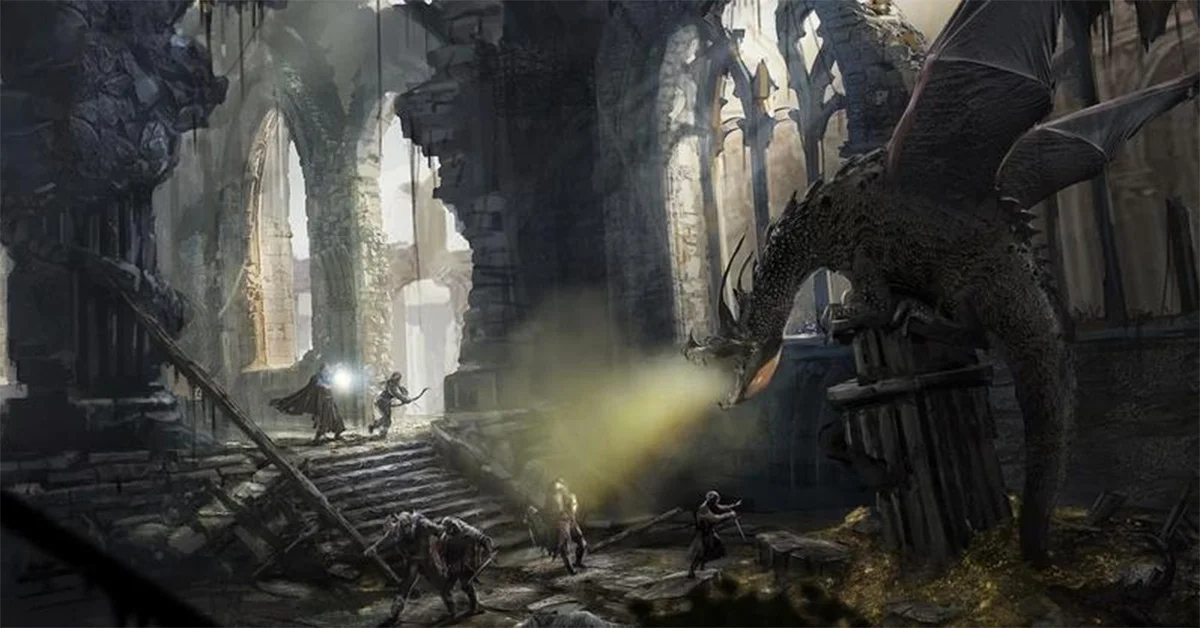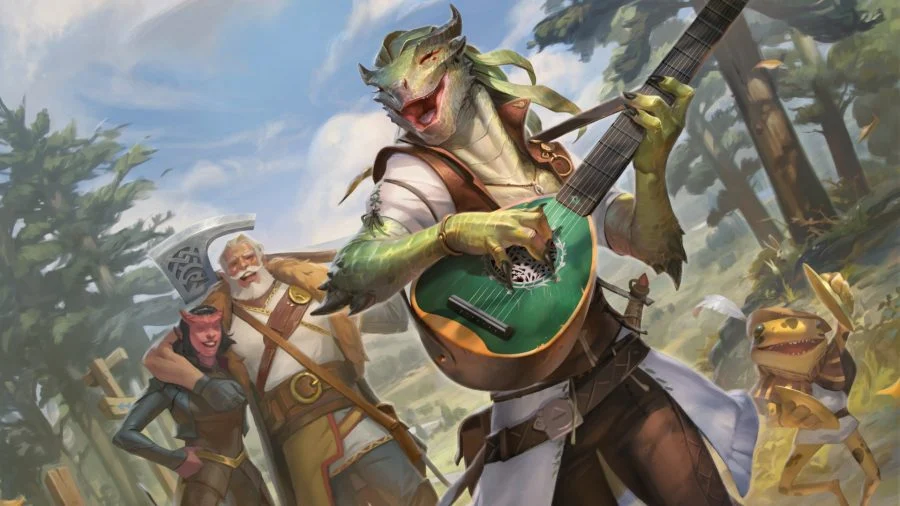
So you’re at a crossroads: you’ve been invited to play a game of swords and sorcery - Dungeons and Dragons - for the very first time. You’re excited and eager, but also feeling anxious and uncertain.
How the heck do you even play this game?
Whether you’re invited by a close friend, coworker, or even a gaming buddy online, you need a real guide to help you swing your axe in the right direction. The good thing is, you’ve teleported to the right place!
Welcome to Joey's Journeys. This is where I share my passion for Dungeons and Dragons with fellow players and Dungeon Masters alike. D&D is a game of imagination, strategy, and adventure that has captured the hearts of millions (and it’s illustrated in pop culture like never before). It offers endless possibilities for creating and exploring fantastical worlds, all while having fun with friends.
In this blog post, I will be guiding you on how to play Dungeons and Dragons for the first time. I go through the basics of how to play D&D, including creating a character, understanding game mechanics, and tips for role-playing. Whether you're a seasoned gamer or a complete newbie, this post will provide you with valuable insights to help you embark on your first D&D adventure.
Step 1: What is D&D? Here it is in 30 words

Alright, I’ll describe Dungeons and Dragons for you in as few words as possible. Here we go:
D&D is a cooperative tabletop game where you and your friends become heroes, slay monsters, and embark on epic adventures in a world limited only by your collective imagination.
There you go, 30 words as promised!
In slightly more detail, the entire game is played in a 3-step phase by the Player Characters (PCs) and Dungeon Master (DM):
Describe: The DM describes the setting and the environment to the players (Example: You enter a gloomy courtyard filled with mysterious fog, foliage, and humming crystals).
Interact: The players then decide to interact with the environment in some way (Player: I stand still, look and listen for a few moments. Can I see or hear anything?)
Resolve: The DM resolves the interaction, with or without calling for a die roll (DM: As you wait, you hear a strange yowl as you see shadows appear from the mist).
Step 2a: Getting Your Group Together
Playing D&D is a group activity, so the first step is to gather a group of like-minded people to join you on your adventure (if you already have a group and a Dungeon Master, skip to Step 3).

You can start by reaching out to your friends, coworkers or family members who might be interested in playing.
Another option is to look for local D&D communities in your area, which can be found through game stores, online forums, or social media groups. If you're having trouble finding people in person, there are also many online resources available for finding a group, such as Roll20, Reddit or Meetup. Don't be afraid to step out of your comfort zone and make new connections – you might just find some lifelong gaming buddies.
Step 2b: Make Sure to Have A Great Dungeon Master

A Dungeon Master (or DM) is a player with a unique role in the game. Their job is to narrate the adventure for you, facilitate the play, and determine the result of player actions in the game world. In fact, you cannot play D&D without a DM, period.
Playing for the first time with strangers is challenging if you don’t have any personal mutual connections. I’d highly recommend looking at your friend circle for Dungeon Masters and seeing if they’re willing to take on new players or host a One Shot (single session) game for your group.
If you have someone in your group that’s willing to learn as a DM, that’s great (even if it’s you). If you’re playing with a new Dungeon Master, I’d highly recommend that they pick up a pre-written module so they can understand how the game works.
Subscribe For Your Free D&D One-Shot Adventure
Soon, I’ll include access to my free D&D 5e One-Shot adventure: Night at the Museum of Stranger Science for email subscribers when it’s ready.
Step 3: Create or Choose Your Character

Selecting a class is the singular most important thing to do as a new player. Your class determines your character's core strengths and specialty. This is important whether or not you decide to get a premade sheet from your Dungeon Master or when making one from scratch.
Here are the 13 classes in D&D 5th edition along with a brief overview of their core strengths:
Barbarian - A fierce warrior with high hit points and damage output, relying on brute strength and rage to defeat enemies.
Bard - A versatile class with spells, musical abilities, and support options, able to adapt to any situation.
Cleric - A divine spellcaster with healing abilities and strong support options, able to channel the power of their deity to aid their allies.
Druid - A nature-based class with spells, shape-shifting abilities, and a connection to the natural world.
Fighter - A skilled warrior with a wide range of weapon and armour proficiency, able to excel in combat with a variety of techniques.
Monk - A disciplined warrior with impressive mobility, unarmed combat proficiency, and unique abilities such as deflecting missiles.
Paladin - A holy warrior with spells and divine abilities, able to smite enemies and protect allies with their faith.
Ranger - A skilled hunter with tracking abilities, nature-based spells, and combat proficiency with ranged weapons.
Rogue - A nimble and stealthy class with proficiency in skills such as lock-picking, trap-finding, and pick-pocketing, as well as sneak attack abilities in combat.
Sorcerer - A spellcaster with innate magical abilities and a focus on raw magical power and damage output.
Warlock - A spellcaster with a pact with a powerful otherworldly being, granting them unique abilities and spells.
Wizard - A spellcaster with a wide range of spells and magical abilities, able to specialize in specific schools of magic.
Artificer - A class that blends magic with technology, able to create and enhance magical items and constructs.
You can watch more Youtube videos about each class to find one that aligns with your play style and interests.
These are just brief overviews of each class's core strengths, and each class has its own unique abilities, strengths, and weaknesses. No class is inherently better than the other, but some classes are more popular and easier to pick up for new players.
Option A: Creating Your Character From Scratch
Creating a character yourself is a classic part of learning how to play D&D. This approach is more like diving in the deep end of the pool. You throw yourself in the game, flipping through the player’s handbook and exploring abilities, race/ancestry, backgrounds, weapons, spells and character personality.
Here’s a basic checklist you can reference while creating your first D&D character:
Choose a Class: This is a good starting point. Ask yourself: “What do I want to play as… What does my character want to be best at?”
Choose a Race/Ancestry: From hardy dwarves to the mighty Dragonborn, pick a race/ancestry that goes with your concept.
Backstory: It's important to develop a backstory for your character, including their motivations, fears, flaws and desires. Note: Don’t feel too much pressure to have a super complex backstory for your first game. A quick one-liner can do the trick for the sections: “I’ll do anything for anyone who risks their life for me… I have tunnel vision the moment I see glittering gold and treasure,” etc.
Ability Scores: You'll need to assign ability scores and skills, which will affect your character's success in various tasks throughout the game. Talk to your Dungeon Master on how to determine your ability scores as each group may do this differently (point buy, dice rolling etc).
I was a new player once and I know how big that book feels for the first time. If this seems like too much to take on just to try out DnD, I don’t blame you! That’s why I usually recommend using a premade (or pre-generated) character.
Option B: Use Premade or Pregenerated Characters

If creating a character from scratch seems daunting, don't worry – many Dungeon Masters provide pre-made character sheets that you can use instead.
These sheets already have race, class, ability scores, and skills assigned, making it easy for new players to jump right into the game without feeling overwhelmed. Personally, I like these level 3 character sheets by Joe Nittoly. They include spell descriptions all written down and it's done in a tidy handwritten serif font.
While you may not have as much control over your character's backstory and personality, pre-made sheets can still be a great option for those who want to focus on learning the game mechanics and getting into the action.
Using a D&D Character Generator

A fun alternative to a premade character is a pre-generated character. These are made via tools online to quickly determine a character after filling in a few quick values (the generator on DnD Beyond is pretty intuitive).
With a pre-made character sheet, you can start playing D&D right away and discover the joys of this immersive and exciting game with little prep.
You’ll still need to check with your Dungeon Master on what’s allowed while pre-generating your D&D character, but it’s a much faster way compared to doing it from scratch.
With either method, be sure to choose a character that aligns with your play style and interests. Don't be afraid to ask your Dungeon Master for guidance or clarification on anything you don't understand.
Step 4: How to Play Dungeons and Dragons: Quick Game Mechanics & Rules

Understanding the mechanics of Dungeons and Dragons is essential to becoming a skilled player.
D&D Dice
The game involves rolling various dice to determine the success of your character's actions. The most important die is called a D20. The dice for D&D range from four-sided to twenty-sided.
Anytime you see a number after a “D”, this corresponds to the number of faces a die has (ie: a D8 would have 8 sides).
Types of Encounters
There are generally 3 aspects of gameplay you encounter as a Player: Combat, Exploration, and Roleplaying. If you’re a Dungeon Master, check my previous blog for tips on designing memorable D&D encounters.
Combat Basics

Depending on your table, battles can be a significant aspect of D&D. Combat involves fighting minions, and terrible foes like Dragons and Minflayers. Combat is also the more complicated aspect.
At the beginning of a combat encounter, the DM will tell players to “Roll For Initiative”. This roll triggers a turn order in which players and monsters fight.
D&D gets into a turn-based game in combat. As a player, it’s best to think ahead of what you’ll be doing on your turn. During your turn, you are able to take an Action (plus sometimes a Bonus Action), and Move. A basic turn would be as follows:
Action: Rascal the Rogue fires their short bow at the Ogre. The bolt hits! (they roll damage)
Bonus Action: Rascal has a special ability to Dash as a Bonus Action, doubling their speed for the turn.
Movement: Rascal runs away from the Ogre, as the creature doesn’t hve time to swing its Greatclub at them. Rascal dashes 50 feet away behind some barrels.
There are other rules for Reactions and special actions like grappling as well, but now you should get the basic idea of combat. The DM will pit foes against you while you need to accomplish an objective. The goal could involve simply defeating a villain or perhaps retrieving a valuable item.
Exploration Basics

Simpler to grasp at first than combat, exploration encounters are simply discovering and interacting with the environment around you.
This part of D&D relies on colourful, detailed map design and in-depth descriptions given by the Dungeon Master while Players interact with them. Anything from a dungeon crawl involving traps, clues, and crime scenes to charting a map of an unexplored wilderness area are good examples of exploration.
Exploration in D&D is all about creating a sense of wonder and discovery as you and your party journey through the game world. It's a chance to uncover hidden secrets, find treasure, and encounter unique characters and creatures.
Whether you're exploring ancient ruins, traversing treacherous terrain, or navigating a cavernous maze-like dungeon, every step you take could lead to a new adventure or perilous encounter. With exploration, there are no limits to where you can go or what you can discover, and every decision you make can have a profound impact on your journey.
Roleplaying Basics

Roleplaying encounters in D&D are all about bringing your character’s personality to life and immersing yourself in the game world.
No, you don't need to be a top-notch voice actor. All you need to do is attempt to get yourself in the shoes of your character. Think like they would think, act as they would act, and speak as your character.
Pro Tip: Your Ability Scores are the foundation of your character. How would someone with a low Wisdom Score act? Perhaps they're naive, reckless, and have little life experience outside their hometown. A low Dexterity character may have a permanent injury that prevents them from being nimble.
Roleplaying happens both within the party and externally with other NPCs (or non-player characters).
For example, you may be setting up camp for a night and talking with your allies about recent trials you've faced, or perhaps you're formulating a plan on how to stop a ferocious monster terrorizing the locals. Or maybe you're having some interparty conflict based on morals and recent choices.
Of course, roleplaying opportunities are plentiful within urban-centred D&D games. Whether you're haggling with a merchant, convincing a king to lend you aid, or trying to charm your way past a guard, roleplaying encounters allow you to explore the social and diplomatic aspects of the game without resorting to combat.
These encounters often require you to think both creatively and strategically, using your character's skills, abilities, and personality to achieve your goals. Roleplaying advances the plot and uncovers new quests, It can also lead to unexpected alliances, friendships, and even guild member status for your character.
Step 5: Start Playing D&D

Now that you have your group, your characters, and a basic understanding of the game mechanics, it's time to start playing Dungeons and Dragons!
The Dungeon Master (DM) will typically begin by describing the setting and situation, and then guide the players through the game world, introducing them to new characters, locations, and challenges.
As you play, the DM will use a combination of storytelling, rules, and chance (via dice rolls) to create a dynamic and immersive game experience. It's important to pay attention to the DM's descriptions and ask questions if anything is unclear.
As you progress through the game, remember to stay in character and think creatively to overcome obstacles and achieve your goals. And most importantly, have fun and enjoy your first D&D adventure with your friends!
Subscribe Today & Keep Learning D&D as a Player and/or Dungeon Master
As a subscriber, you'll have access to insightful tips for DMs and players, as well as answers to all your D&D questions. Keep up with the latest content on character creation, encounter building, world creation, and more. Whether you're a seasoned veteran or just starting out, Joey's Journeys has something for everyone.
Consider becoming a Patron to support my ongoing quest to create amazing D&D content for your games.
